Ravi Bhavnani (2003)
Adaptive Agents, Political Institutions and Civic Traditions in Modern Italy
Journal of Artificial Societies and Social Simulation
vol. 6, no. 4
To cite articles published in the Journal of Artificial Societies and Social Simulation, please reference the above information and include paragraph numbers if necessary
<https://www.jasss.org/6/4/1.html>
Received: 23-Feb-2003 Accepted: 1-Jun-2003 Published: 31-Oct-2003
 Abstract
Abstract

|
| Figure 1. Map of Italy with Inherited Institutional Structures |
Note: This figure shows the contours of model landscape - a geographic map of Italy divided into the four 14th Century regimes - featured in Putnam's Study. The landscape contains a total of 36 rows and 32 columns.
| Cultural Features | ||||
| ai,1 | ai,2 | ai,3 | ai,4 | |
| ↓ | ↓ | ↓ | ↓ | |
| 3 | 2 | 9 | 4 | 4 |
| ↑ | ||||
| ai,0 | ||||
| Tag denoting regime in which agent is situated | ||||
| Figure 2. Description of an Agent | ||||
Note: An agent i is comprised of 4 cultural features that correspond to the four dimensions of civicness used by Putnam - engagement, political equality, trust, and membership in associations. Each feature may assume one of nine values that represent the agent's level of civicness on the given feature, with "1" being the lowest possible level of civicness and "9" the highest possible level of civicness on a given feature. Agents also carry a tag or extra feature identifying their geo-political location. In the communal republics and ex-communal republics, agent tags are set equal to 1 and 2 respectively. Agents in the Papal-states have tags set equal to 3, whereas agents in the feudal monarchy have tags equal to 4.

|
| Figure 3. The Landscape: 14th Century Political Institutions with Typical Initial Population of Agents |
Note: The model landscape is populated with agents. Each cell on the landscape represents one agent. The actual size of the landscape is twice that of the picture presented here, containing a total of 36 rows and 32 columns and is host to 320 agents.

|
| Figure 4. Map of Italy with Randomly Generated Population |
Note: The map in this figure is generated by MATLAB and displays a population of 320 agents with randomly assigned cultural features. In this figure, each cultural feature on an agent is assigned a color to denote its value, as indicated by the key to the right of the map. Four adjacent cells on the map represent one agent. Agent tags are not displayed.

|
| Figure 5. Schema of the Computational Model |

|
| Figure 6. An Example of Agent Interaction |
Note: An agent i is selected to initiate interaction (circled in black), and a neighbor j is selected to interact with i (circled in grey). The third feature (in blue) is selected for interaction on both agents. If θ=0.225, the agents interact with 63% probability. In the event that interaction occurs, i increases her level of civicness on the selected feature by +1, and i is consequently denoted by the string 43179 while j's features remain unchanged.
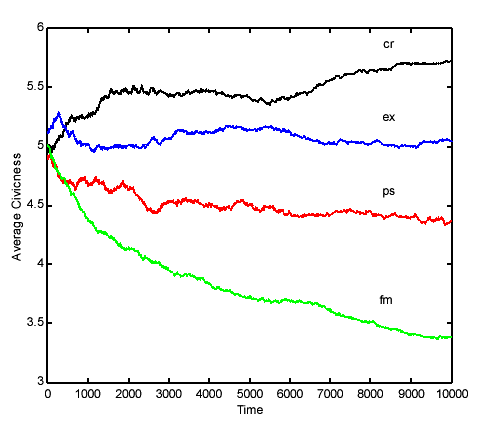
|
| (a) |
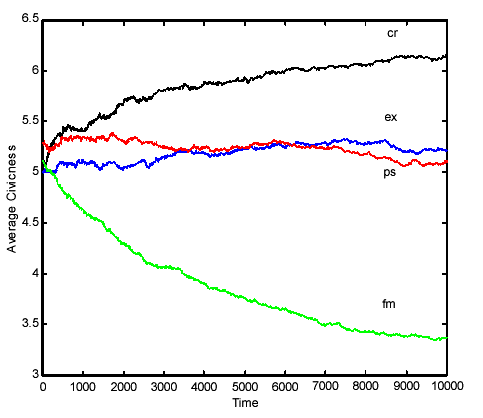
|
| (b) |
| Figure 7. Evolution of Civicness by Region |
Note: Figures 7a and 7b depict changes in the aggregate level of civicness in each of the four regions - (cr) denotes the communal republics, (ec) the ex-communal republics, (ps) the Papal-states, and (fm) the feudal monarchy - for two independent runs of the model (t=10,000, θ=0.225).
| Table 1: Institutional Effectiveness and Aggregate Civicness | |||||
| | Communal Republics | Ex-Communal Republics | Papal States | Feudal Monarchy | Civic Change |
| ai,0 = | 1 | 2 | 3 | 4 | |
| θ=0.125 | 6.0284 | 5.7750 | 5.54740 | 5.0609 | 14899 |
| (α=0.875) | (α=0.750) | (α=0.625) | (α=0.500) | ||
| θ=0.175 | 5.8683 | 5.4655 | 4.80571 | 4.2887 | 14279 |
| (α=0.825) | (α=0.650) | (α=0.475) | (α=0.300) | ||
| θ=0.225 | 5.8091 | 5.1734 | 4.36719 | 3.3728 | 13011 |
| (α=0.775) | (α=0.550) | (α=0.325) | (α=0.100) | ||
| θ=0.250 | 5.7990 | 5.0948 | 4.10208 | 2.9072 | 13894 |
| (α=0.750) | (α=0.500) | (α=0.250) | (α=0.000) | ||
| σ2 | 0.0112 | 0.0958 | 0.3991 | 0.9207 | |
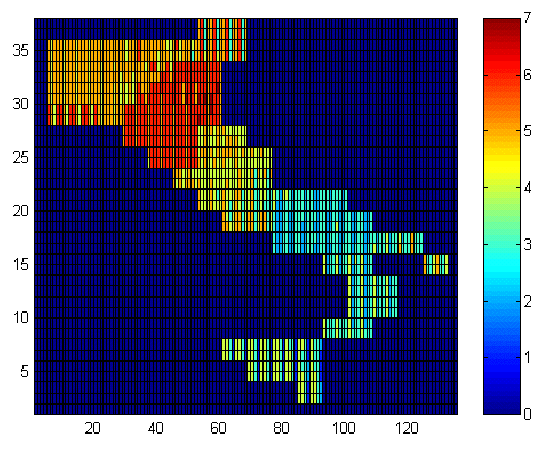
|
| (a) θ = 0.25 (ineffective institutions) |
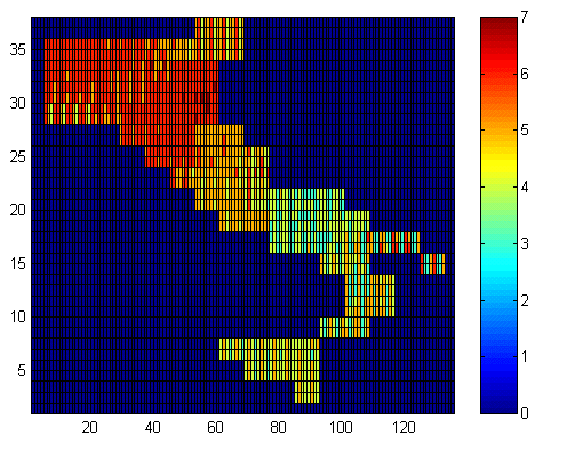
|
| (b) θ = 0.175 (moderately effective institutions) |
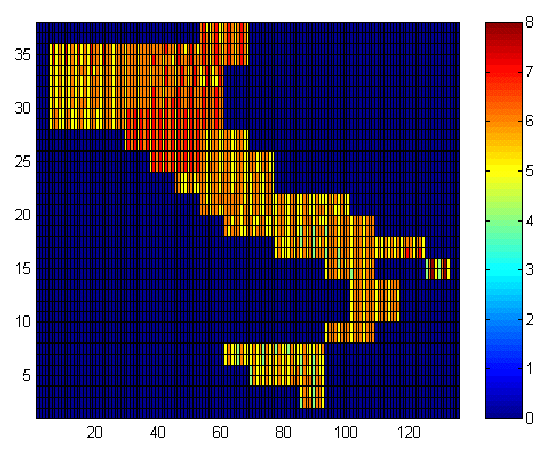
|
| (c) θ = 0.125 (highly effective institutions) |
| Figure 8. Comparative Institutional Effectiveness |
| Table 2: Political Boundaries and Aggregate Civicness | |||||
| Regional Boundaries | Communal Republics | Ex- Communal Republics | Papal States | Feudal Monarchy | Civic Change |
| No | 5.3369 | 5.3242 | 4.3479 | 3.4736 | 16971 |
| Yes | 5.8091 | 5.1734 | 4.3672 | 3.3728 | 13011 |
| Table 3: Historical Shocks and Aggregate Civicness | |||||
| Timing of Shock | Communal Republics | Ex- Communal Republics | Papal States | Feudal Monarchy | Civic Change |
| 1,000 | 5.4760 | 5.1033 | 4.3854 | 3.0840 | 13661 |
| 3,000 | 5.3413 | 5.3016 | 4.9740 | 3.2461 | 15200 |
| 5,000 | 5.2837 | 5.2935 | 4.8438 | 3.2520 | 15682 |
| 7,000 | 5.1587 | 5.4429 | 4.7760 | 3.6348 | 16274 |

|
| Figure 9. Evolution of Civicness with Historical Shocks |
Note: The figure displays changes in the aggregate level of civicness from four independent runs of the model (t=10,000, θ=0.225) for agents in the communal republics. Historical shocks that lowered the civicness of the republic's inhabitants by 30% were introduced at t=1,000, t=3,000, t=5,000, and t=7,000.
| Table 4: Assessing Path Dependence | |||||
| Number of Episodes | Communal Republics | Ex-Communal Republics | Papal States | Feudal Monarchy | Civic Change |
| 16,000 | 6.0962 | 5.3207 | 5.1667 | 3.4023 | 14414 |
| 17,000 | 5.7163 | 5.0380 | 4.5521 | 3.6074 | 14025 |
| 18,000 | 5.6827 | 4.7962 | 3.8750 | 3.6367 | 14113 |
| 19,000 | 6.2260 | 5.2582 | 4.9115 | 3.3359 | 14353 |
| Experiment Average | 5.9303 | 5.1033 | 4.6263 | 3.4956 | 14226 |
| Average Without Experiment | 5.8091 | 5.1734 | 4.36719 | 3.3728 | 13011 |
2 My definition of institutions as mechanisms to provide individuals with reputational information on potential interaction partners is deliberately narrow in this paper.
3 The simulations reported in the paper were run on MATLAB. Please contact the author for the program code.
4 An alternative method is to model state-led assimilation which would differ from the strictly local interaction topology modeled here. The state could be modeled as a distinct cultural string communicating with "villages" within its territory, thereby introducing tension between the decentralized mechanism for cultural change specified here and a central actor.
5 Population estimates from the 13 th Century are available for a number of major cities, although these cities do not account for each of the contemporary regions of Italy.
6 Putnam does not include Sardegna in his depiction of 14 th Century Italy. As a result, I left Sardegna out of the model.
7 I note at the outset that the boot-shaped landscape introduces some peculiarity into the simulation, particularly in the form of boundary effects.
8 To measure civicness, Putnam assesses the vibrancy of associational life, the incidence of newspaper readership across the Italian regions, regional differences in turnout in successive public referenda, and the incidence of preference voting (which reflects clientalistic obligations).
9 One can therefore think of agents as individuals in established territorial domains or "villages," to borrow a term used by Axelrod (1997: 99) in his model of social influence. Mobile agents can be introduced in the model, although this remains a task for future research.
10 Agent i may have a maximum of eight neighbors, although if i was to be located on an edge or a region's boundary she may have fewer than eight neighbors. I later relax this condition, and permit agents to interact across political boundaries although the edge effects remain.
11 This assumes that the least effective institutions have the greatest room for improvement.
12 I assume that the effect of interaction is one-sided to avoid forced cultural change, that is change imposed by a on b. The assumption can be relaxed in future versions of the model.
13 ai,0=4, θ=0.225, and α=0.1 ai,3=6 and aj,3=9, so δ=0.1(0.9*6 + 0.1*9)=0.63.
AXELROD, R. 1997. "The Dissemination of Culture: A Model with Local Convergence and Global Polarization." The Journal of Conflict Resolution 41:2 (April):203-206.
AXELROD, R. and S. Bennet. 1993. "A Landscape Theory of Aggregation." British Journal of Political Science 23:2 (April):211-233.
BARKAN, J., M. McNulty, and M. Ayeni. 1991. "Hometown Voluntary-Associations, Local Development, and the Emergence of Civil Society in Western Nigeria." Journal of Modern African Studies 29:3 (September):457-480.
BARTLETT, R. 1993. The Making of Europe: Conquest, Colonization and Cultural Change. Princeton: Princeton University Press.
BERNHARD, M. 1993. "Civil Society and Democratic Transition in East Central Europe." Political Science Quarterly 108:2 (Summer):307-326.
BOND, D.; J. C. Jenkins; C. Taylor and K. Schock. 1997. "Mapping Mass Political Conflict and Civil Society: Issues and Prospects for the Automated Development of Event Data." The Journal of Conflict Resolution 41:4 (August):553-579.
BOOTH, J. and P. Richard. 1998. "Civil Society, Political Capital, and Democratization in Central America." The Journal of Politics 60:3 (August):780-800.
BOYLE, P. 1996. "Parents, Private Schools, and the Politics of an Emerging Civil Society in Cameroon." Journal of Modern African Studies 34:4 (December):609-622.
BREHM, J. and W. Rahn. 1997. "Individual-Level Evidence for the Causes and Consequences of Social Capital." American Journal of Political Science 41:3 (July): 999-1023.
CASTI, J. 1998. Would-Be Worlds: How Simulation is Changing the Frontiers of Science. New York: John Wiley and Sons.
COHEN,M., R. Riolo, and R. Axelrod. 2000. "The Role of Social Structure in the Maintenance of Cooperative Regimes." Rationality and Society 13 (2000): 5-32
COLEMAN, J. 1988. "Social Capital in the Creation of Human-Capital." American Journal of Sociology 94 (Supplement):S95-S120.
DI PALMA, G. 1990. To Craft Democracies: an Essay on Democratic Transitions. Berkeley: University of California Press.
EMERSON, R. 1969. "The Problem of Identity, Selfhood, and Image in the New Nations: The Situation in Africa." Comparative Politics 1:3 (April):297-312.
GILBERT, N and P. Terna. 1999. "How to build and use agent-based models in social science." Mind and Society 1(May): 57-72.
GLASER, D. 1997. "South Africa and the Limits of Civil Society." Journal of Southern African Studies 23:1 (March): 5-25.
GOLDBERG, E. 1996. "Thinking About How Democracy Works." Politics and Society 24:1 (March ):7-18.
GOLDSTONE, J. 1998. "Initial Conditions, General Laws, Path Dependence, and Explanations in Historical Sociology." American Journal of Sociology 104:3 (November):829-845.
GREIF, A. 1992. "Institutions and International Trade: Lessons from the Commercial Revolution." American Economic Review. 82:2 (May):128-33.
GREIF, A. 1992. "Historical Perspectives on the Economics of Trade." Journal of Economic History 82:2 (May):128-33.
GREIF, A., P. Milgrom, and B. Weingast. 1994. "Coordination, Commitment and Enforcement: The Case of the Merchant Guild." Journal of Political Economy 102:4 (August):745-76.
HARROP, J. 2000. The Political Economy of Integration in the European Union. England: Elgar.
HOLLAND, J. 1998. Emergence: From Chaos to Order. Massachusetts: Addison-Wesley.
HOLLAND, J. and J. Miller. 1991. ``Artificial Adaptive Agents in Economic Theory.'' (with J. Holland) American Economic Review, Papers and Proceedings 81 (May):365-70.
KAPIL, A. 1995. "History of Algeria Since Independence." Middle East Journal 49:2 (Spring): 339-341.
KIM, S. 1997. "State and Civil Society in South Korea's Democratic Consolidation: Is the Battle Really Over?" Asian Survey 37:12 (December):1135-1144.
KOTZE, H. and P. Du Toit. 1995. "The State, Civil Society, and Democratic Transition in South Africa: A Survey of Elite Attitudes." The Journal of Conflict Resolution. 39:1 (March):27-48.
LEVI, M. 1996. "Social and Unsocial Capital: A Review Essay of Robert Putnam's Making Democracy Work." Politics and Society 24:1 (March):45-55.
LIEBOWITZ, S.J. and E. Margoliss. 1995. "Path-Dependence, Lock-In, and History." Journal of Law, Economics, and Organization 11:205-226.
MAHONEY, J. 2001. The Legacies of Liberalism: Path Dependence and Political Regimes in Central America. Baltimore: Johns Hopkins Press.
MCKAY, D. 1996. "Urban Development and Civic Community: A Comparative Analysis." British Journal of Political Science 26:1 (January):1-23.
MONGA, C. 1995. "Civil-Society and Democratization in Francophone Africa." Journal Of Modern African Studies 33:3 (September):359-379.
MULLER, E. and M. Seligson. 1994. "Civic Culture and Democracy: The Question of Causal Relationship." The American Political Science Review 88:3 (September):635-652.
NORTH, D. 1981. Structure and Change in Economic History. New York: W.W. Norton.
NORTH, D. 1990. Institutions, Institutional Change, and Economic Performance. Cambridge: Cambridge University Press.
OXHORN, P. 1995. Organizing Civil Society: the Popular Sectors and the Struggle for Democracy in Chile. University Park: Pennsylvania State University.
PAXTON, P. 1999. "Is Social Capital Declining in the United States? A Multiple Indicator Assessment," American Journal of Sociology 105:1 (July): 88-127.
PEDERSON, T. 1994. European Union and the EFTA Countries: Enlargement and Integration. New York: St. Martin's Press.
PIERSON, P. 2000. "Increasing Returns, Path Dependence, and the Study of Politics." American Political Science Review. 94:2 (June):251-267.
PROSSER, G. and W. R. Louis. 1982. The Transfer of Power in Africa: Decolonization 1940-1960. New Haven: Yale University Press.
PUTNAM, R. 1993. Making Democracy Work: Civic Traditions in Modern Italy. Princeton: Princeton University Press.
REILLY, C. (ed.). 1995. New Paths to Democratic Development in Latin America: The Rise of NGO-Municipal Collaboration. Boulder: Lynne Rienner Publishers.
RICE, T. and J. Feldman. 1997. "Civic Culture and Democracy from Europe to America." The Journal of Politics 59:4 (November): 1143-1172.
RONIGER, L. and A. Gunes-Ayata (eds.). 1994. Democracy, Clientelism, and Civil Society. Boulder: Lynne Rienner Publishers.
SABETTI, F. 1996. "Path Dependency and Civic Culture: Some Lessons From Italy About Interpreting Social Experiments." Politics and Society 24:1 (March): 19-44.
SPRUYT, H. 1994. The Sovereign State and Its Competitors. Princeton: Princeton University Press.
SULLIVAN, D. J. 1996. "NGOs in Palestine: Agents of Development and Foundation of Civil Society." Journal of Palestine Studies 25:3 (Spring):93-100.
TAMARI, S. 1990. "Limited Rebellion and Civil Society: The Uprising's Dilemma." Middle East Report 164/165 (May-August):4-8.
TARROW, S. 1996. "Making Social Science Work Across Space and Time: A Critical Reflection on Robert Putnam's Making Democracy Work." American Political Science Review 90:2 (June):389-397.
TILLY, Ch. (ed.). 1975. The Formation of National States in Western Europe. Princeton: Princeton University Press.
VARSHNEY, A. 2002. Ethnic Conflict and Civic Life: Hindus and Muslims in India. New Haven: Yale University Press.
WAPNER, P. 1995. "Politics Beyond the State: Environmental Activism and World Civic Politics." World Politics 47:3 (April): 311-340.
WEINBAUM, M. 1996. "Civic Culture and Democracy in Pakistan." Asian Survey 36:7 (July):639-654.
YANSANE, A. Y. 1980. Decolonization and Dependency: Problems of Development Of African Societies. Westport: Greenwood Press.
Return to Contents of this issue
© Copyright Journal of Artificial Societies and Social Simulation, [2003]